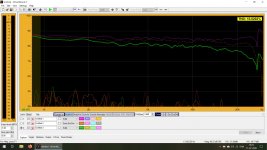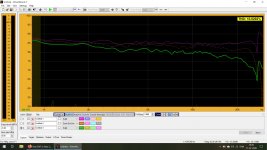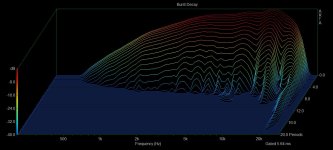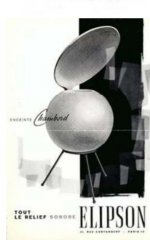Sure, I'm not looking for 0,1mm matching, just something close enough to have good phase tracking in fairly wide range around the XO frequency using symmetric filters (same order on mid LP and tweeter HP). +/- a couple of mm is fine, but not cm. I use mic position centered between drivers, to simulate far field listening. I usually measure at 0,5-1m distance.
Last edited:
The problem as understand it.... is, that a normal dome has a bad shape to couple with a waveguide, cause the distance from the dome to the waveguide is not constant. But if you use an XT25, the bullet in the middle - cause it's the suspension that actually plays - will have a better uniform coupling with a waveguide. Also some BE domes are better, cause they are flatter - compared to a normal dome, which are almost like a ball. Dibble domes from SB should work well too.I do have a pair of WG300's in their boxes, but not for this..
These tweeters will be paired with M13 mids, so the WG300 is a bit over sized I think. Too large diameter for looks, and most likely too deep for time alignment. I don't want to go active with these. I thought the WG148 would fit the bill, but failed due to space issues. What will you use the DXT with? Would be interesting to know the delay you get to align it, assuming you use symmetrical XO. (Just put a symmetrical filter on mid & DXT, run them out of phase, and adjust the delay until you get the deepest null with mic between tweet & mid centers)
I have a Seas Excel Magnum right no, which I like. So I want to keep using a harddome. I also both have a set of Accuton 5" midranges and a set of 4,5" midranges from an old set of Acoustic Energy speakers - which are designed with a mix of an alu cone and neo magnets. I will refer to a build thread, when the tweeters arrive 🙂
I will measure it in a baffle with cuts like these:
DXT-MON | 5 ″ 1 ″ | Near field monitor | Compact speaker
Then I will find out how each driver works, where it can be crossed and where I get the best result.
That looks like a very nice and simple design - but still with great results and possibility for finetuning 🙂🙂I found this, and it suggests pretty good TA with a small woofer with phase plug (like my M13).. www.audioexcite.com >> Prestigious Two – Monitor DXT
Well, I have done some quick tests with the XT + WG.
First with a 90deg diy WG in a piece of 16mm MDF. I filled the gap with some 'goo' to get it sealed to the faceplate and the correct shape closest to the dome. It looked ok except a pretty sharp peak around 2,5k. I tried a bigger roundover from the 'horn' to the baffle surface, but that did not do much.
Then I tried to mount it on the Visaton WG. Removed the faceplate, and used even more goo to seal and shape the gap. This was not a hit either. Top end was flat (no boost) from WG, and below abt 4,5k there was a big bump from the WG. not easy to EQ in XO. Maybe because it was monted too deep, I don't know.
I also managed to drop the XT and crack the second magnet, and have the lid to the rear chamber come off, so that tweeter can't be used for anything 'serious' any more.
Bad day!
I guess this makes me lean more towards using the DXT anyway.
First with a 90deg diy WG in a piece of 16mm MDF. I filled the gap with some 'goo' to get it sealed to the faceplate and the correct shape closest to the dome. It looked ok except a pretty sharp peak around 2,5k. I tried a bigger roundover from the 'horn' to the baffle surface, but that did not do much.
Then I tried to mount it on the Visaton WG. Removed the faceplate, and used even more goo to seal and shape the gap. This was not a hit either. Top end was flat (no boost) from WG, and below abt 4,5k there was a big bump from the WG. not easy to EQ in XO. Maybe because it was monted too deep, I don't know.
I also managed to drop the XT and crack the second magnet, and have the lid to the rear chamber come off, so that tweeter can't be used for anything 'serious' any more.
Bad day!
I guess this makes me lean more towards using the DXT anyway.
Last edited:
I got a pair of DXT:s too, but I'm struggling a bit with the sound.
Measures well, but I find the treble a bit harsh and bright on cymbals for example. Sometimes it sounds just 'detailed' but most of the time it's too much for my ears. There was a wow-effect at first, but pretty quick I found the sound tiring.
I will do some more measurements and try to understand the problem. Maybe some XO adjustments etc. I tried to play around with EQ (EqAPO) in the PC, but no luck so far.
Measures well, but I find the treble a bit harsh and bright on cymbals for example. Sometimes it sounds just 'detailed' but most of the time it's too much for my ears. There was a wow-effect at first, but pretty quick I found the sound tiring.
I will do some more measurements and try to understand the problem. Maybe some XO adjustments etc. I tried to play around with EQ (EqAPO) in the PC, but no luck so far.
Ok... harsh? I sense nothing different with mine, compared to other tweeters... other than better directivity and more "controllede" sound.
Something else in your sound-chain, that is giving you trouble?
Something else in your sound-chain, that is giving you trouble?
Well, I have done some quick tests with the XT + WG.
First with a 90deg diy WG in a piece of 16mm MDF. I filled the gap with some 'goo' to get it sealed to the faceplate and the correct shape closest to the dome. It looked ok except a pretty sharp peak around 2,5k. I tried a bigger roundover from the 'horn' to the baffle surface, but that did not do much.
Then I tried to mount it on the Visaton WG. Removed the faceplate, and used even more goo to seal and shape the gap. This was not a hit either. Top end was flat (no boost) from WG, and below abt 4,5k there was a big bump from the WG. not easy to EQ in XO. Maybe because it was monted too deep, I don't know.
I also managed to drop the XT and crack the second magnet, and have the lid to the rear chamber come off, so that tweeter can't be used for anything 'serious' any more.
Bad day!
I guess this makes me lean more towards using the DXT anyway.
Top end will never get any boost, the peaks lower like 2.5kHz is more likely why you have a bad result. it takes a lot of equalising to get rid of harshness...
Yes I know, the disappointment in this test was that the boost from the wave guide was abrupt, and not a smooth rise easy to compensate in the XO. I did not use the WG combination, I only did a quick test to see if it would be feasible.
I got the DXT tweeters, and those are the ones I'm having some 'subjective issues' with.
I got the DXT tweeters, and those are the ones I'm having some 'subjective issues' with.
Ok... harsh? I sense nothing different with mine, compared to other tweeters... other than better directivity and more "controllede" sound.
Something else in your sound-chain, that is giving you trouble?
Maybe/maybe not.. I actually tried another amp too. My setup is only PC->sound card->amp. The sound card is used for measurements too, so it is tested in loop-back many times, and has pretty good performance. Amplifier is a slightly modified class A JLH, and is also measured many times. Smoothest sounding amp I have heard so far. Distortion is below -80dB, and only 2nd and 3rd order harmonics visible above 120dB noise floor.
I run playback in 44kHz sampling rate, and from memory there is very steep filtering at 22kHz in 44kHz mode, so there should be nothing there exciting the 27kHz dome resonance.
I did some measurements on the DXT with dual tones watching the FFT, and there was significant IMD in the audible range if there was a 27kHz tone (dome resonance) combined with an audible tone. So, I definitely don't want to feed extra noise in the 20k+ range to the tweeter.
I plan to do some more measurements soon.
Just to add: I have some hearing issues, so my hearing is very sensitive to some sounds/frequencies, I get tinnitus and I easily get headaches from some amps I have tested, and some speakers really annoy me too.
Last edited:
Seas DXT measurements
I did some measurements on the DXT tweeter. I measured it at abt 15cm distance in the speaker with my XO connected. Same source as when I listen to music. SPL is not calibrated, all I can say is that it's abt normal listening level (not so loud). A few averages per FFT. I did the frequencies that have 2nd and 3rd harmonics at the 27,3kHz dome resonance to see how it behaved too.
I really don't see much wrong with it from a measurement point of view. Some delays in the decay (ok, and one huge 🙂 ) Suggestions on other measurements?
Oh, and on the subjective side, it seems to please my ears more if I notch it around 10k (in the PC). Maybe the resonances seen in the decay?
I did some measurements on the DXT tweeter. I measured it at abt 15cm distance in the speaker with my XO connected. Same source as when I listen to music. SPL is not calibrated, all I can say is that it's abt normal listening level (not so loud). A few averages per FFT. I did the frequencies that have 2nd and 3rd harmonics at the 27,3kHz dome resonance to see how it behaved too.
I really don't see much wrong with it from a measurement point of view. Some delays in the decay (ok, and one huge 🙂 ) Suggestions on other measurements?
Oh, and on the subjective side, it seems to please my ears more if I notch it around 10k (in the PC). Maybe the resonances seen in the decay?
Attachments
-
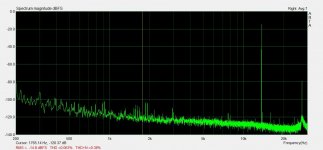 13k FFT.jpg83.8 KB · Views: 86
13k FFT.jpg83.8 KB · Views: 86 -
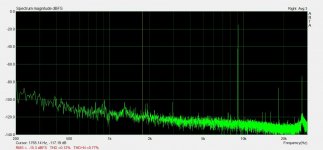 9k FFT.jpg86.6 KB · Views: 93
9k FFT.jpg86.6 KB · Views: 93 -
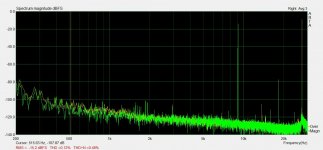 9_1 vs 9_1k 27k.jpg92.1 KB · Views: 98
9_1 vs 9_1k 27k.jpg92.1 KB · Views: 98 -
 5k FFT.jpg82.9 KB · Views: 99
5k FFT.jpg82.9 KB · Views: 99 -
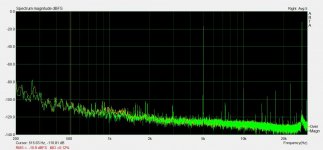 5k 27k FFT.jpg89 KB · Views: 286
5k 27k FFT.jpg89 KB · Views: 286 -
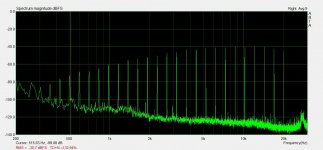 multitone FFT.jpg94.7 KB · Views: 297
multitone FFT.jpg94.7 KB · Views: 297 -
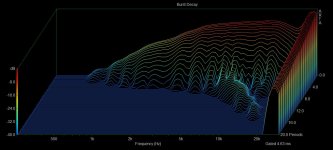 decay.jpg156 KB · Views: 298
decay.jpg156 KB · Views: 298 -
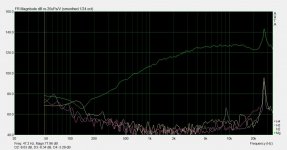 dist sweep.jpg95.8 KB · Views: 306
dist sweep.jpg95.8 KB · Views: 306 -
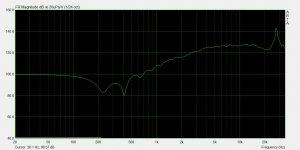 FR.jpg69.7 KB · Views: 290
FR.jpg69.7 KB · Views: 290
Last edited:
Can you elaborate on that a little?
It looks to me that a notch would not matter as long as the input signal is free of 27kHz content? In the measurements I was running at 192k sample rate, and exciting the resonance, but with music I run 44kHz and there is nothing to excite the 27k peak. I actually don't worry too much about anything over 12k, since I won't hear it anyway..
Even with the resonance excited by 2nd & 3rd harmonics in the tweeter, it does not seem to reflect much back into the audible range. But in this case a notch should not make any difference.
It looks to me that a notch would not matter as long as the input signal is free of 27kHz content? In the measurements I was running at 192k sample rate, and exciting the resonance, but with music I run 44kHz and there is nothing to excite the 27k peak. I actually don't worry too much about anything over 12k, since I won't hear it anyway..
Even with the resonance excited by 2nd & 3rd harmonics in the tweeter, it does not seem to reflect much back into the audible range. But in this case a notch should not make any difference.
I've somehow missed the part where you wrote sr of your music, i agree - if you are using 44kHz music, the notch is not needed since the resonance will never be excited. Similar to D&D.
Last edited:
Listen to the DXT everyday now. With youtube talks, movies, music and games. I play all kinds of music - pop from the 80' and 90' and moderne crazy electronic creative music from youtube and my collection from old CD - now played from my NAS via an Allo Digione player - works great.
The great thing about the DXT, is the even dispersion. It seems like it is less affected by my room. Cymbals from voices and hard hits on piano keys, are more clear and not annoying - like they can be.
One of my favorites with piano right now, is Peter Bence:
Queen - Don't Stop Me Now | Piano Cover - Peter Bence - YouTube
I really dont think about tweeters or integration with midrange or the like..... it just seems to work nicely 🙂
The great thing about the DXT, is the even dispersion. It seems like it is less affected by my room. Cymbals from voices and hard hits on piano keys, are more clear and not annoying - like they can be.
One of my favorites with piano right now, is Peter Bence:
Queen - Don't Stop Me Now | Piano Cover - Peter Bence - YouTube
I really dont think about tweeters or integration with midrange or the like..... it just seems to work nicely 🙂
I'm happier with it now too. Some adjustments to XO bringing down some mild breakups in the mid improved things. The acoustic offset matches the M13 mid pretty well, giving straight forward XO with LR2 acoustic slopes with 2nd order electrical + parallel RC (in series with DXT) to straighten out the DXT response.
I must say the DXT measures very smooth on a wide baffle (Troels PMS copy), and so does the other drivers. Smoothest FR I ever measured. Wide and smoothly curved baffle.
I must say the DXT measures very smooth on a wide baffle (Troels PMS copy), and so does the other drivers. Smoothest FR I ever measured. Wide and smoothly curved baffle.
Rallyfinnen, I read you find sounds of speakers boring and generate headache, this is due to lack of "presence", "intelligibility ", articulated voice",US, Europe,Japan, of direct radiating transducers. This phenomena was known to those passing from horns to direct radiators where straight cones were used. The solution in early 30's to enhance the "presence"..... etc the diaphragm became exponential or corrugated or ecliptic, some as you did for the tweeter add a wave guide , whereas Joseph Leon, got the idea to reflect the sound by an ellipsoid afterwards in 50's by a paraboloid .
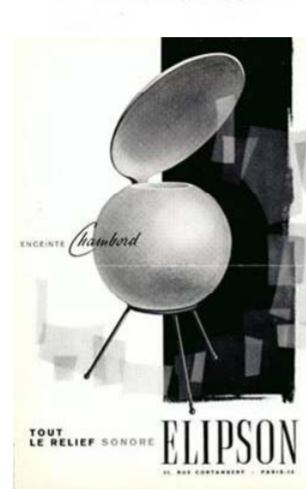
my version is here corner Chambord with passive radiating sphere
To see how it sounds, get any speaker facing upwards and direct the sound to horizontal by a large fruitdish or kettle cover or a prabola dish. You will here how the voice will approach the microphone, the voice becomes intelligible .
Hayk
my version is here corner Chambord with passive radiating sphere
To see how it sounds, get any speaker facing upwards and direct the sound to horizontal by a large fruitdish or kettle cover or a prabola dish. You will here how the voice will approach the microphone, the voice becomes intelligible .
Hayk
Attachments
@kokoriantz
I'm impressed by your wide knowledge and different ideas! (from reading solid state section) 🙂
I did some basic dipole tests that did not really do it for me for stereo. I suspect I don't like the room to be too much in the sound. The details and 'focus' got lost, and the sound was diffused to the whole room. But if moving around or sitting in different positions it seems like a good compromise to involve the room more.
Maybe the parabolic reflector enhances the focus and mimics a larger radiating area? Maybe I should try it.. just don't think I have any parabolas around 🙂
Some kind of reflector setup has actually been on my 'want to try' list, even if I was thinking more of a 360 radiating type for the surround system. I found that aiming the rear surround speakers towards the wall to reflect the sound via the walls was more to my taste for movies, so I thought it would be interesting to explore this more. I think for surround sound, less 'focus' is good, and gives nicer 'ambience' and seating position is not critical. Details lost in early reflections don't seem to matter so much.
At the moment my ears are experiencing/exploring the sound of wide baffles (with sealed box), that is an interesting experience, and I like it so far.
I'm impressed by your wide knowledge and different ideas! (from reading solid state section) 🙂
I did some basic dipole tests that did not really do it for me for stereo. I suspect I don't like the room to be too much in the sound. The details and 'focus' got lost, and the sound was diffused to the whole room. But if moving around or sitting in different positions it seems like a good compromise to involve the room more.
Maybe the parabolic reflector enhances the focus and mimics a larger radiating area? Maybe I should try it.. just don't think I have any parabolas around 🙂
Some kind of reflector setup has actually been on my 'want to try' list, even if I was thinking more of a 360 radiating type for the surround system. I found that aiming the rear surround speakers towards the wall to reflect the sound via the walls was more to my taste for movies, so I thought it would be interesting to explore this more. I think for surround sound, less 'focus' is good, and gives nicer 'ambience' and seating position is not critical. Details lost in early reflections don't seem to matter so much.
At the moment my ears are experiencing/exploring the sound of wide baffles (with sealed box), that is an interesting experience, and I like it so far.
- Home
- Loudspeakers
- Multi-Way
- Seas DXT vs Seas 27TBFC/G + WG300

